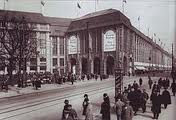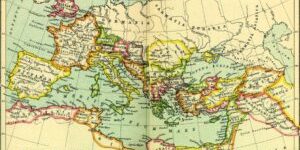What Will Be The Long-Term Development Of The Population Of The German Reich After The First World War? – Introduction and Abstract
No Comments yetGeneral Introduction
The 1920’s and 1930’s are among the most interesting periods in the history of modelling and forecasting. The continuous decline of Western birth rates in the inter-war period set alarm bells ringing. Concerns about the future size and growth of the populations of these nations were heightened by long-term extrapolations of time series, and by population projections and population forecasts. Concerns turned to acute anxiety after it became to appear that the leading Western European nations would not replace their populations. The imminent population decrease threatened to diminish the relative power of what were called in those days the ‘civilized’ nations and ultimaltely to result in ‘race suicide’ (the extinction of populations).
In some countries statisticians, demographers, or economists developed population projection methodology in order to free current debates on the population issue from emotional, subjective argument. In the two leading Fascist countries – but in other countries as well – population numbers were seen as the key to economic, political and military strenght.
From the book Populations, Projections and Politics. Critical and Historical Essays on Early Twentieth Century Population Forecasting. Edited by Jochen Fleischhacker, Henk A. de Gans and Thomas Burch, The Rozenberg Quarterly already published the essay by Henk A. de Gans – The Innovation of Population Forecasting Methodology in the Inter-War Period: The Case of The Netherlands.
As second essay from the book we present: Wie wird sich die Bevölkerung des Deutschen Reiches langfristig nach dem Erstem Weltkrieg entwickeln? Die ersten amtlichen Bevölkerungsvorausberechnungen in den 1920er Jahren.
In this essay Jochen Fleischhacker discusses the first official population forecasts of the German Reich in the 1920s. After the end of Wold War I concern in the German Reich increased that a slowing/deteriorating growth of population could have lasting consequences for society and the economy. This concern was based on population forecasts computed by official Reich statisticians in the 1920s. These calculations were primarily based on the initial demographic position of Germany after the end of World War 1. A quantifying of future demographic developments/trends was founded on different assumptions relating both the natural increase and to migration. Fertility trends before and after 1918 became a center of interest. The question of future demographic development influenced by this continuously decreasing birth rate was a focal point of the authors of the first official population forecast published by the German Statistical Office (Das Statistisches Reichsamt) in 1926.
Following the ideas of the American biologist Sir Peter Brian Medawar (1915-1987), one could say that forecasters were led by the illusion that the complexity of the factors which influence fertility behaviour could be summed up in only one number. Measurements such as the net reproductive rate (NRR) became the numerical expression of the fertility behavior of the population. Differential fertility became a central feature of the demographic forecasts and was used for constructing “high and low quality” sub-populations, for instance for invalids and widows. This social classification was seen as associated with differences in the reproductive behavior, and as having direct implications for population policy. These 1926 projections showed clearly what high social costs the German Reich was going to face. Various possibilities in the realm of social and family policies were discussed in order to get a grip on the declining birth and fertility rates. Suggestions for material and non-material support of families and for securing the social situation of the ageing population of Germany were broadly discussed after 1930. Surprisingly enough it is hard to find any previous studies of this discussion.
Abstract: What Will Be The Long-Term Development Of The Population Of The German Reich After The First World War? The first official population forecasts in the 1920s.
This article will acquaint the reader with the first demographic forecasts of the national statistical office of the German Reich, which were carried out in the 1920s. I will discuss the major changes in the age structure of the population of Germany during and after the First World War. In addition, I will analyse the calculation models used and the results, in addition to sketching out the implications for population politics.
The First World War meant the end of steady population growth and also the end of a balanced age structure of the population (cf. Graph 9.1, see Article = referring to the article by Prof.dr. Fleischhacker published next to this abstract- – Age structure for the German population after the census from 1925 and the present area of territory after 1919 (Altersaufbau der Bevölkerung im Deutschen Reich nach der Volkszählung 1925 und dem Gebietstand nach 1919)) During the war years the population decreased by 5.9 million, dropping to a level of “just” 61.9 million. Demographic development was disrupted by the war in several ways: there were drastic reductions in the number of marriages and births, increases in the average age at marriage for both men and women and, of course, an enormous increase in mortality for young men. The official statistical reports summarised the changing age and sex structure of the population with the words: “more adults, but fewer children”.
Comparing the statistics of 1925 to those of 1910, the percentage of children under 15 decreased by 17.9% and that of 15 to 65 year-olds by 20%. At the same time the percentage of people over 65 years of age increased by 25.6%. Between 1914 and 1919 there were approximately 3.3 million fewer children born than would have been normal. Declines in the birth rate were also a standard feature of post-war times. In 1912 the percentage of children under 15 of the total population was 33.9. This dropped by 1925 to 25.8%.
Losses in the male population affected the age groups above 20. They led to a long-term imbalance in the sex structure of the population in the form of a large excess of women (cf. Graph 9.2, see article – Numbers of people who died or soldiers killed in action in age groups (in 1000) (Die im Weltkrieg gefallenen und gestorbenen deutschen Militärpersonen nach Altersjahren (in 1000)). This phenomenon had a significant influence on marriage trends. In 1913 the average age at first marriage was approximately 27.5 for men. It rose to 29.0 by 1919.
The corresponding figure for the female population rose in the same period from 24.7 to 26.0. According to statistical estimates there were about 870,000 fewer marriages during the war years than one normally would have expected. As a result, birth rates dropped from 27.1‰ in 1913 to 22.1‰ in the years from 1921 to 1925.
Against the backdrop of these disturbances in the structure and total size of the population the German statistical office produced its first population forecasts in 1926. They predicted that shifts in age structure would determine demographic trends for the coming decades. Their aim was to forecast population growth and developments in birth rates for the period from 1925 to 1975 (cf. Graph 9.3, see article– Marriages, Birth and Death in Germany, 1. First quarter 1913 -3. quarter 1925 (per 1000 inhabitants) (Eheschliessungen, Geburten und Sterbefälle im Deutschen Reich, 1. Vierteljahr 1913 – 3. Vierteljahr 1925, (auf 1000 Einwohner))).
They assumed constant age-specific mortality rates over this period. In addition, they assumed a closed population. Age-specific marital fertility was considered the decisive factor influencing future population developments. Mean values of age-specific fertility were calculated for the respective five-year child-bearing age groups on the basis of average marital fertility in the years 1924-1925. The degree of participation of the respective five-year age group in annual marital fertility was determined along with the size of the child-bearing age groups. The change factor for the marriage trend was calculated under the assumption that the proportion of married women in all age groups would change to the same extent as the entire stock of female population. The forecasts were carried out for three hypothetical cases of development. In the first case the annual number of live births within wedlock from 1925 to 1927 remains constant at the level of 1923. In the second case marital fertility remains at the average level of live births calculated for the years 1924 and 1925, taking into consideration the number of live births in 1923. In the third case marital fertility sinks from the average of the years 1924-1925 at a decreasing pace by a total of 25% up to the year 1955. After that marital fertility remains constant.
The results of these three different forecasts show the extent to which the number of live births and marital fertility is influenced by the age structure of the female population of childbearing age (Graph 9.4, see article – Number of births and marital fertility combined with the three assumed development
cases. Assumption: I Number of births is constant to 1975; II marital fertility is constant to 1975; III marital fertility is declining to 1955 at 25% and after this period constant (Zahl der Lebendgeborenen und die eheliche Fruchtbarkeit gemäss den drei für die Berechnungen angenommenen Entwicklungsfällen)).
The calculations exhibit noticeable changes particularly in the third case. As a consequence of the significant decrease in marital fertility and the structural changes stemming from the entrance of the numerically weak birth years of 1915 to 1919 into the age group with the “highest fertility”, the annual number of births drops constantly. This trend determines the long-term demographic development, leading to an uneven age distribution and to altered population dynamics. In all three cases of potential development there is a decrease in population growth, which occurs more or less rapidly, however,depending on the individual case (cf. Graph 9.5, see article – Development of the total population from 1925 to 1975 with the three assumed development cases. I Number of births is constant to 1975; II marital fertility is constant to 1975; III marital fertility is declining to 1955 at 25% and after this period constant. (Die Entwicklung der Bevölkerungszahl von 1925 bis 1975 unter der Annahme I, II und III)).
On the basis of the forecasts of the total population the Statistical Office made calculations for the development of the corresponding birth- and death rates for the period 1925-1975.
These forecasts show once again, in all three cases, a rapidly aging population (cf. Graph 9.6, see article – Development of Births and Deaths (in 1000 of the total population) (Die Entwicklung der Geburten- und Sterbeziffer (in 1000 der Bevölkerung))).
A second, entirely new forecast was carried out in 1930 for a period of over 75 years. The main focus was on the downward trend in births and fertility in the postwar years. This development was interpreted as a “conscious will to limit the rearing of children”. The substantive question was whether future demographic developments would be characterised by wavelike drops in the number of births resulting from the combination of structural changes and waning reproductive behaviour. To estimate future population development a calculation model was chosen for evaluating the interaction of age-structure and average rates per women. Changed individual marital fertility behaviour is viewed as the most influential component. A trend is calculated for marital fertility for the entire female population of childbearing age for the years 1922 to 1927. For purposes of determining standardised fertility rates, structural influences and the changed age structure of women of childbearing age or fluctuations in economic trends are not taken into consideration. In order to be able to judge the changes in marital developments, one first determined the proportion of married women of childbearing age.
First, one calculated standardised age-at-marriage figures for the male population in relation to marital frequency for the years 1910/1911, in order to be able to calculate the difference between expected and actual marriages for each age group in the years 1924 to 1927. The connections between altered marriage frequency and reproductive behaviour of the entire population were determined on the basis of data on marital trends in Prussia. Taken in reference to marriage duration and birth parity of the first, second, third, fourth and further births, these data show a decline in first and second births for the years 1922 to 1927. Mortality assumptions for the forecast, were based on the German life table for 1924-1926, and age-specific mortality figures were taken to be constant over the projection period. Emigration and immigration flows were excluded from the calculations.
To calculate the birth and marital fertility trends two hypothetical cases were formulated.
In the first case (A), the annual number of live births remains equal to the number of live births in the year 1927.
In the second case (B), marital and extra-marital fertility declines from the level of 1927 by a total of 25% by 1955. The shifts in age and sex structure of the population stemming from the First World War continue wavelike into the future under the conditions of both hypothetical cases. The transition of the boom years (people born between 1905 and 1909) from middle age to the over-65 age group means an increase in the percentage of elderly (cf. Graph 9.7, see article – Changes in the composition of age groups which are influenced through the ageing of the present total population (Veränderungen in der Besetzung der Altersklassen durch das Altern des gegenwärtigen Bevölkerungsbestandes)). The relative number of people married drops after 1940, as the low-birth generation born during the war moves into the age groups with the highest marriage frequency.
The results of these three different forecasts show the extent to which the number of live births and marital fertility is influenced by the age structure of the female population of childbearing age (Graph 9.4, see article – Number of births and marital fertility combined with the three assumed development cases.
Assumption: I Number of births is constant to 1975;
II marital fertility is constant to 1975;
III marital fertility is declining to 1955 at 25% and after this period constant (Zahl der Lebendgeborenen und die eheliche Fruchtbarkeit gemäss den drei für die Berechnungen angenommenen Entwicklungsfällen)).
The calculations exhibit noticeable changes particularly in the third case. As a consequence of the significant decrease in marital fertility and the structural changes stemming from the entrance of the numerically weak birth years of 1915 to 1919 into the age group with the “highest fertility”, the annual number of births drops constantly. This trend determines the long-term demographic development, leading to an uneven age distribution and to altered population dynamics. In all three cases of potential development there is a decrease in population growth, which occurs more or less rapidly, however,depending on the individual case (cf. Graph 9.5, see page 172 – Development of the total population from 1925 to 1975 with the three assumed development cases.
I Number of births is constant to 1975;
II marital fertility is constant to 1975;
III marital fertility is declining to 1955 at 25% and after this period constant. (Die Entwicklung der Bevölkerungszahl von 1925 bis 1975 unter der Annahme I, II und III)).
On the basis of the forecasts of the total population the Statistical Office made calculations for the development of the corresponding birth- and death rates for the period 1925-1975.
These forecasts show once again, in all three cases, a rapidly aging population (cf. Graph 9.6, see article – Development of Births and Deaths (in 1000 of the total population) (Die Entwicklung der Geburten- und Sterbeziffer (in 1000 der Bevölkerung))).
A second, entirely new forecast was carried out in 1930 for a period of over 75 years. The main focus was on the downward trend in births and fertility in the postwar years. This development was interpreted as a “conscious will to limit the rearing of children”. The substantive question was whether future demographic developments would be characterised by wavelike drops in the number of births resulting from the combination of structural changes and waning reproductive behaviour. To estimate future population development a calculation model was chosen for evaluating the interaction of age-structure and average rates per women. Changed individual marital fertility behaviour is viewed as the most influential component. A trend is calculated for marital fertility for the entire female population of childbearing age for the years 1922 to 1927. For purposes of determining standardised fertility rates, structural influences and the changed age structure of women of childbearing age or fluctuations in economic trends are not taken into consideration. In order to be able to judge the changes in marital developments, one first determined the proportion of married women of childbearing age. First, one calculated standardised age-at-marriage figures for the male population in relation to marital frequency for the years 1910/1911, in order to be able to calculate the difference between expected and actual marriages for each age group in the years 1924 to 1927. The connections between altered marriage frequency and reproductive behaviour of the entire population were determined on the basis of data on marital trends in Prussia. Taken in reference to marriage duration and birth parity of the first, second, third, fourth and further births, these data show a decline in first and second births for the years 1922 to 1927. Mortality assumptions for the forecast, were based on the German life table for 1924-1926, and age-specific mortality figures were taken to be constant over the projection period. Emigration and immigration flows were excluded from the calculations.
To calculate the birth and marital fertility trends two hypothetical cases were formulated. In the first case (A), the annual number of live births remains equal to the number of live births in the year 1927. In the second case (B), marital and extra-marital fertility declines from the level of 1927 by a total of 25% by 1955. The shifts in age and sex structure of the population stemming from the First World War continue wavelike into the future under the conditions of both hypothetical cases. The transition of the boom years (people born between 1905 and 1909) from middle age to the over-65 age group means an increase in the percentage of elderly (cf. Graph 9.7, see article – Changes in the composition of age groups which are influenced through the ageing of the present total population (Veränderungen in der Besetzung der Altersklassen durch das Altern des gegenwärtigen Bevölkerungsbestandes)). The relative number of people married drops after 1940, as the low-birth generation born during the war moves into the age groups with the highest marriage frequency.
The surplus of women in the age groups 25 to 50 leads to an increase in the number of so-called late marriages. To calculate the number of live births and marital fertility, a third case of potential development (C) was added: marital and extra-marital fertility remains constant at the level of 1927.
Above all in this third case, one sees that transition of the generation born in the low-birth years of 1915 to 1919 into childbearing age from 1935 to 1945 introduces a decrease in the number of births. These trends continue into the future as well.
Graph 9.8, see article – Numbers of Births and Development of Fertility (Zahl der Lebendgeborenen und Geburtenhäufigkeit) shows the development of case A in relation to the number of births and of case B in relation to marital fertility from 1927 to 2000. In case A marital fertility drops up to 1935 at the same rate as the number of live births rises, assuming constant marital fertility. Comparing the curves for the number of births and of marital fertility, we see that as early as 1927 the level of marital fertility was too low to keep the annual number of births constant. The consequence of a marital fertility level that is too low is wavelike drops in births, which are greatest under the conditions of the second case (B).
The population dynamics inherent in case B lead to a loss of population starting in 1945 (cf. Graphs 9, see article – Expected development of the total population in the German Reich (Voraussichtliche Entwicklung der Bevölkerungszahl im Deutschen Reich) and Graph 9.10 Expected changes of the age structure of the total population (Die voraussichtlichen Veränderungen des Altersaufbaus der Bevölkerung)). The birth surplus drops until it reverses into a surplus of deaths in the year 1945. The drop in population that starts in 1945 accelerates thereafter. The constant decrease in the number of births means that each age group will be smaller than the one immediately preceding it. As a consequence, a new population structure is formed with “an urn that narrows as one moves downwards” and whose base becomes ever narrower (cf. Graph 9.10, see article: The white structure means the population structure for assumption A; the black structure means the population structure for assumption B). The different shapes in the age structure of case A and B have in common the fact that both exhibit an ageing of the population in general. In case B, this process is notably more dynamic: the actual birth rate and the population dynamics independent of the age structure of the population was calculated on the basis of stationary and stable population models. The Statistical Office used the theoretical methods developed by Alfred J. Lotka (1880-1949) for the calculation of the stationary and stable population model.
Instead of the NRR (Net Reproduction Rate), which was developed by Lotka, the Statistical Office calculates the value J which is approximated to NRR. Then the value J is calculated in order to prove these assumptions: the future development of total numbers of life births and the birth rate. The results
give a different picture of the replacement of the generation of mothers with the generation of daughters, as well as the decline of total population and the ageing process of the population (cf. Graph 9.11, see article – Development of Birth and Death rates (per 1000 of the total population) (Entwicklung der Geburten- und Sterbeziffer (je 1000 der Bevölkerung))).
In case B the transition from a birth surplus to a death surplus occurs already in 1936, and the population begins to shrink. The long-term effects of imbalances in age structure and of the changes in reproductive behaviour on the part of the female population on population dynamics and size are portrayed in the theoretical population model of a stable age structure. The statistical office carried out separate calculations based on the examples of population trends regarding invalids and widows, as well as of (widows’) pensions. They show clearly what high social costs the German Reich was going to be saddled with.
Various possibilities in the realm of social and family policies were discussed in the interest of getting a grip on the declining birth and fertility rates. For example: changes in the system of compensation for families with many children, various models for increasing the tax burden of childless couples and singles while lowering the burden for families with children, and the introduction of subsidies for the rearing of children in families with two children. These allowances were intended as a financial incentive for having a third child. There have been hardly any studies of the broad discussion of suggestions that took place after 1930 for the material and non-material support of families and for securing the social situation of an ageing population. It remains for future research to close the gap of our knowledge of this discussion.
—
This abstract accompanies the essay: Wie wird sich die Bevölkerung des Deutschen Reiches langfristig nach dem Erstem Weltkrieg entwickeln? Die ersten amtlichen
Bevölkerungsvorausberechnungen in den 1920er Jahren published in: Populations, Projections and Politics. Critical and Historical Essays on Early Twentieth Centruy Population Forecasting. Edited by Jochen Fleischhacker, Henk A. de Gans and Thomas Burch.
Published in 2003 by Rozenberg Publishers.
Also published in the Rozenberg Quarterly: Henk A de Gans – The Innovation of Population Forecasting Methodology in the Inter-War Period: The Case of The Netherlands.
Comments
Leave a Reply









